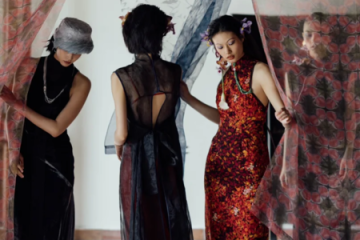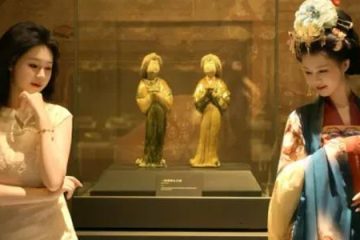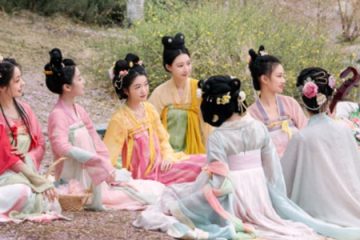What Are the Different Types of Hanfu?

We’ve already talked about many types of hanfu in previous posts, but this time let’s do a big roundup. Think of it as a handy guide that marks out the main styles, who they’re for, and a few fun facts along the way.
Here, we’re talking about hanfu in the broad sense of Han Chinese dresses. If you’re also curious about “immortal-style” fantasy outfits or stage costumes inspired by hanfu, we’ll touch on those too.
Ⅰ. The Four Basic Hanfu Styles
Hanfu comes in countless variations, but at its core there are just four main styles. Once you know these, you’ve basically mastered the entry level!
1. Yishang System (衣裳制 — the oldest!)
This literally means “top garment + skirt”. The top is a short robe or jacket, and the bottom is a skirt (裳 chang), worn by both men and women.
Classic examples:
- Xuanduan/玄端 (a formal ceremonial outfit from the Zhou dynasty)
- Ruqun/襦裙 (a short jacket called ru paired with a long skirt qun)
Fun fact: This style was formally included in the ritual dress code as early as the Zhou dynasty. It lasted for more than 4,000 years, all the way up until the Qing dynasty’s “haircut and dress reform,” which replaced traditional hanfu with Manchu clothing.

2. Shenyi System (深衣制 — the “one-piece” style)
The Shenyi originated in the Zhou dynasty. It was made by sewing the upper garment and lower skirt together, creating an all-in-one robe. Symbolically, it represents the harmony between heaven and humanity.
This style worked for both men and women and could be worn as either formal attire or everyday clothing. In history, it was often chosen by rulers, officials, and scholars as a more casual yet still respectable outfit outside of strictly ceremonial settings.
Classic examples:
- Quju/曲裾 — with a wrapped, curved front
- Zhiqu/直裾 — a straight-cut robe
- Zhuzi Shenyi/朱子深衣 — a Song dynasty scholar’s version
Best suited for: Proper ceremonies, scholarly gatherings, or anyone wanting that refined “literati” vibe.

3. Yiku System (衣裤制 — the most comfortable, in my opinion!)
This refers to outfits with pants. “Ku” (裤) is a general term for trousers, which came in three main types:
- Undergarment pants (worn inside)
- Outer pants (worn as the main layer)
- Leg wraps or jing yi/胫衣 (tied around the legs for extra protection or practicality)
4. Tongcai (通裁制 — the one-piece robe, a true lazy-day blessing!)
This style is literally “one full piece”—a long robe from top to bottom, suitable for both men and women. It became especially popular during the Tang dynasty, loved by royals, nobles, and scholars alike.
Classic examples:
- Round-collar robe — think of it as the Tang dynasty’s “official uniform”
- Dao robe — the Ming dynasty’s go-to everyday wear for scholars and literati
Fun fact: The round-collar robe was actually a fusion of Han and nomadic styles. Surprising, right?

5. Ruqun System (襦裙制 — the ultimate girly favorite!)
This style is basically “short top + high-waisted or chest-high skirt.” Technically, it’s a branch of the Yishang system, but it’s so iconic that it deserves its own spotlight (and we’ll go into more detail below).
Classic examples:
- Qixiong Ruqun — chest-high skirts, often seen as the “fairy dress” of the Tang dynasty
- Cross-collar Ruqun — a more practical everyday version popular in the Song and Ming dynasties
Heads-up: The chest-high skirt is famous for being a little tricky to keep in place… Ancient women actually tied it extra tight with straps to make sure it didn’t slip (relatable struggle!).

Ⅱ. Five Key Features of Hanfu
1. Crossed Collar with Right Closure (jiaoling youren 交领右衽)
The collar crosses with the left side over the right—this is very important! Wearing it the other way (right over left) was traditionally reserved for the deceased in Han culture. Some ethnic groups, like Tibetans, do wear the left closure normally, but for hanfu, make sure you don’t get it reversed.

2. No Buttons, Only Ties
Chinese dresses has no buttons or zippers—it’s all about straps and ties. So when you see long ribbons swaying as someone walks, they’re not just pretty decorations—they’re basically the outfit’s “seatbelts.”
3. Sleeves and Flowing Skirts
Sleeves come in many shapes:
- Arrow sleeves — slim and neat
- Pipa sleeves — wider, practical (yes, you could even stash small items!)
- Wide flowing sleeves — dreamy and elegant, though not ideal for eating soup.
4. Center Seam with Attached Sleeves
There’s usually a seam running down the center of the garment, symbolizing uprightness and integrity. A little detail that shows how much the ancients cared about symbolism.

5. Hidden Fastenings and Invisible Stitching
Even if there are buttons, they’re hidden. The surface always looks smooth, clean, and minimalist.
Ⅲ. Popular Hanfu Styles Today
1. Qixiong Shanqun (Chest-High Skirt Outfit)
Also known as the Qixiong Ruqun, this style features a skirt tied high above the waist, often right under the chest. It first appeared during the Sui, Tang, and Five Dynasties period, and you can spot it in countless Tang dynasty paintings, figurines, and murals.
The skirt is usually secured just below the arms, and there are two common variations:
- Front-opening (duijin/对襟) — more versatile and widely used
- Cross-collar (jiaoling/交领) — a more traditional wrap style

2. Qiyao Shanqun (Waist-High Skirt Outfit)
Also called the Qiyao Ruqun, this is one of the most popular Chinese dresses styles today. The skirt sits right at the natural waistline, and the short top (ru) can be either cross-collar or straight-collar with a front opening.
Its signature look is the contrast between a short top and a long flowing skirt, creating proportions that reflect the aesthetics of the golden ratio.

3. Beizi (Long Overcoat)
The Beizi dates back to the Sui dynasty. Its name carries the idea of keeping the back straight while walking, symbolizing upright posture and character.
A Beizi usually features a straight collar with a front opening, side slits under the arms, and a length that falls below the knees. It can be fastened with a belt at the waist.
In the Song dynasty, women often wore the Beizi over a moxiong (a type of chest wrap), and the longer version was commonly used as semi-formal attire.

4. Aoqun (Jacket and Skirt Set)
The Aoqun has been around from the Tang dynasty all the way to the early Republic of China. It refers to the combination of a jacket (ao) worn over a long skirt (qun). Today, when people mention Aoqun, they usually mean a jacket with a built-in lining paired with a skirt.

5. Banbi (Short-Sleeved Jacket)
The Banbi is a short outer garment that evolved from the ru (top) during the Wei and Jin periods. It usually has no collar (or sometimes a turned-down one), can be front-opening or pullover style, with sleeves that reach the elbows and a body length ending around the waist.

Summary
Did these introductions help you get a clearer picture of Chinese dresses? In the next post, we’ll dive into some of the fun “insider terms” used in the hanfu community. Stay tuned if you’re curious!



0 Comments